Page 23
Madang, Papua New Guinea
I must apologize for the number of pictures in
this section. I hope it doesn't take too long to load on your screen.
Papua New Guinea is one strange place. It is at once exotic. mysterious
and a little scary. if the people weren't so warm and friendly being in
this place would scare the living daylights out of me. The coastal city
of Medang is surrounded by lush impenetrable jungle. It is so fertile
and has so much rain that we saw a soccer field with grass on it four
feet tall. They only cut it just before a game. There are bats here the
size of raccoons along with the occasional 8 foot snake. A very interesting
place to visit. I hope you enjoy these pictures as much as I did taking
them.

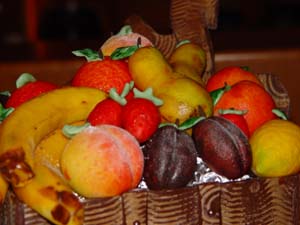

The day before we arrived
in Papua New Guinea, there was a special luncheon which featured some
fresh fruit. the kitchen staff here displayed some of the fresh fruit
recently received.
Here on the other hand is some candy
which looks like fresh fruit. The pastry chef is very
cool. The stuff looked so real that they had to put a huge sign on this
display saying it was for display purposes only. Actually I came back
later and 2 pieces of the candy were gone. Now that must have been really
embarrassing to someone.
And here are some roses which are
really candy in a chocolate basket. Where do they get these ideas?

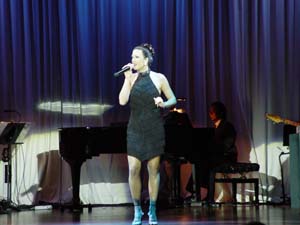

Here is Amy on the
left, one of the two female singers in the show-cast along with our friend
Judy and of course Donna. When not on the ship, can you believe that she
lives in Queens NY. When I was growing up in Queens the girls were realy
cute. Things haven't changed a bit.
Verity Brown, the other female singer
in the production show-cast openned the nights entertainment for a wonderful
comedian, Scott Williams. Having even an average comedian is unusual ,
but this guy really did put a a smile on everyone's face.
Here he is leading an AIR rock band
made up of himself and passengers he dragged onstage from the audience.
He really got the joint jumping.
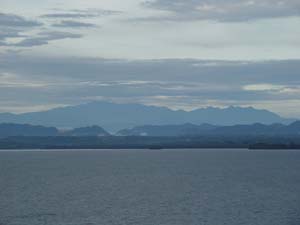
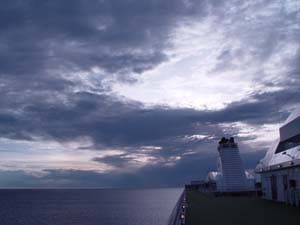
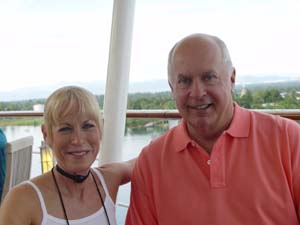
Much of Madang, Papua
New Guinea was under a heavy blanket of haze when we made our approach
in the early morning light. It made the place look mysterious and exotic,
as if the stories of cannibalism and head hunting were not enough.
It had rained heavily the night before and the clouds
in the morning light were spectacular. Just before leaving on our tour
of several coastal villages we had breakfast with Peter who lives in Florida
and whose wife could not make the trip. Can you believe she looked up
our site at her husband's recommendation and she e-mailed us her compliments.
That makes two compliments I've gotten. That is not including friends
and family who are obligated to tell me how wonderful my site is. Since
Peter's wife lives in Florida we've really gone global. Now I know exactly
what Edward R. Morrow felt like during WWII reporting from London during
the Blitz. We're BIG!!!
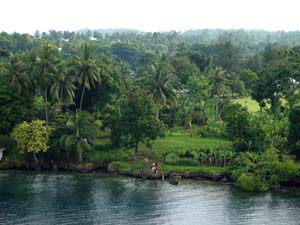

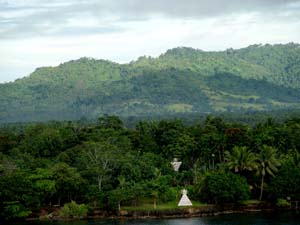
The countryside is covered
by lush jungles.
The harbor's navigational
aids consisted of two triangular sites several hundred feet apart which
when aligned indicated you on the correct course to enter the harbor.
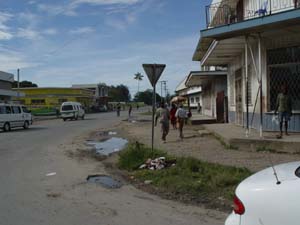
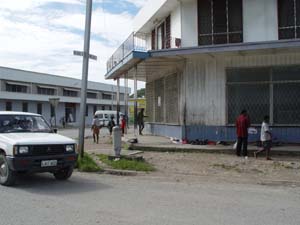
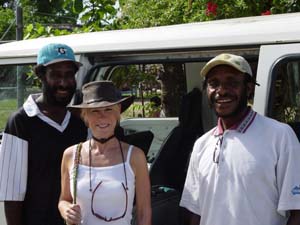
Madang is
a poor city but the people were always friendly and courteous.
Here Donna is making friends with
our bus driver and one of his associates.
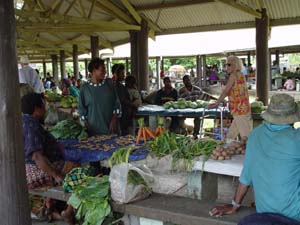

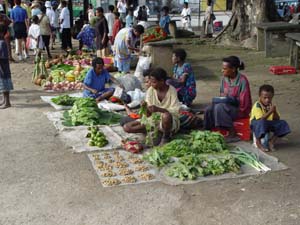
We stopped at the local
market where every type of vegetable and fruit can be purchased. Again
the people were nothing but friendly.
Donna checking out the pocket book
department.
The assortment of goods was impressive
and it was apparent that you could buy in very small quantities.

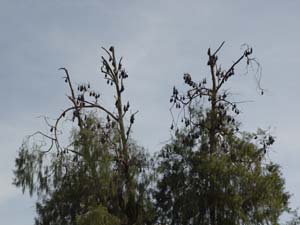
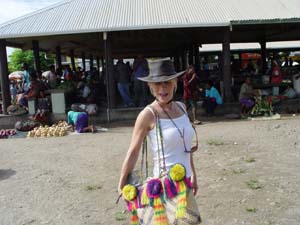
Donna demonstrating
to one of the salespeople the hard sell she learned as an insurance salesperson.
Papua New Guinea has many fox bats
which sleep upside-down in the trees during the day. I was glad we weren't
staying for the night. These guys were big and noisy.
Donna showing off her new pocketbook.
Where'd she get that? I didn't leave her alone for 2 minutes. From now
on I'm holding her hand.
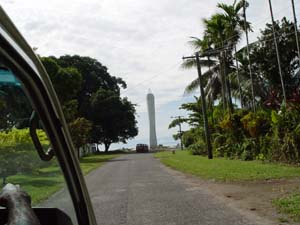
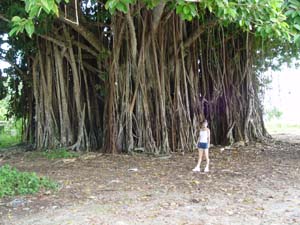

During WWII, several
dozen Australians and New Zealanders lived in the mountains of Papua New
Guinea, which was for some time under Japanese occupation and reported
Japanese ship and troop movements to the Allied commanders using radios.
They were called Coast Watchers. After the war this monument was built
to honor their courage and contribution to the war effort. One day in
this place and I knew that these were pretty tough guys. They were here
for more than two years.
Because of the constant heat and
high humidity and rainfall this place has some very interesting flora.
Here Donna stands next to one of the more interesting trees we encountered.
That's a hell of a tree trunk.
The houses in the nicer neighborhood's
were not bad.
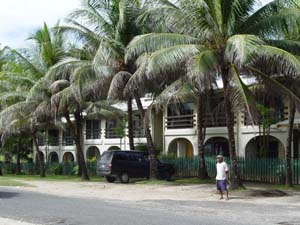


The local motel, which
was adjacent to a golf course looked fine from the outside.
Some of the ship's guests played
a round at this course. From our bus the fairways and greens looked fine.
The main Coast Road was smooth and
pothole free.

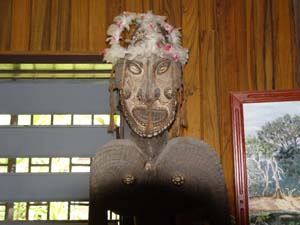
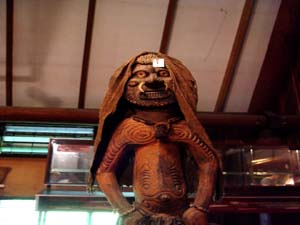
Papua New
Guinea has a reputation for its historic primitive societies. The masks
and carvings attest to this. The only question is "is this stuff
history or current events?" Some of these carved figures were more
than just a little spooky.

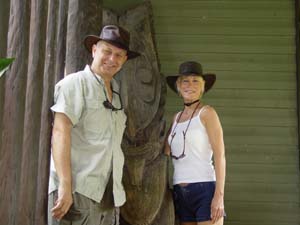
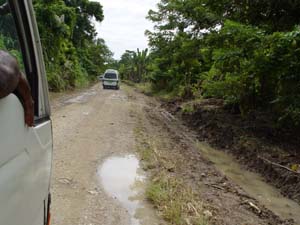
Donna finally making
a new friend ashore.
I' was jealous so I cut in.
We visited two smaller villages
and got there by way of roads which needed much work. It had rained the
night before and the roads were not yet ready for prime time. We traveled
at about 10 miles per hour down the good parts.
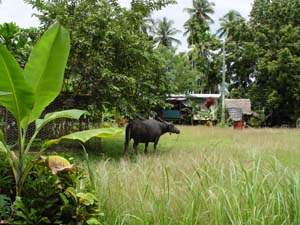

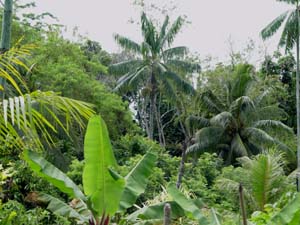
A water buffalo roaming
near the entrance to one of the villages we visited.
Outside of the city, the houses
are built on stilts to make it more difficult for the snakes, mosquitoes,
frogs and other entomology and zoology, which thrives in the adjoining
dense jungle, to join the structure's occupants.
When I said the jungle was dense
I meant dense. In many places you couldn't see 5 feet into it from the
road. Cutting your way through it with a machete would have been a very
tough job for for the natives before the roads were built.
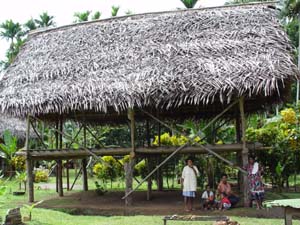
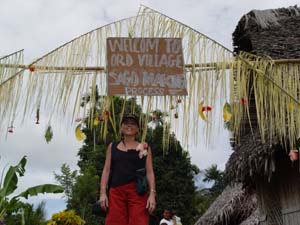

Here is another structure
which like many in the village only provides protection from the sun and
rain.
Here the ship's chief engineer's
wife is found standing under our welcome sign to the Village ORD.
We were treated to a demonstration
of how the locals prepare Sago, which is in a way like their flour which
comes from the inside of the tree shown here.

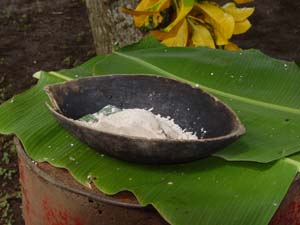

It looks like the kids
got a day off from school.
After the inside of the tree is
chopped out and washed it looks a lot like flour.
From this they make an interesting
type of food which has a hard gelatin consistency . It is wrapped around
another preparation made of lemon grass and then covered in shaved coconut.
It had an interesting taste.
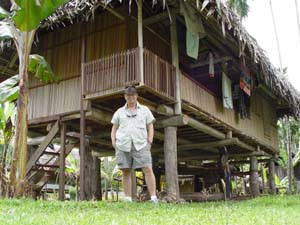
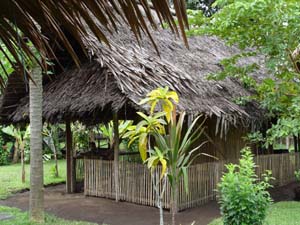
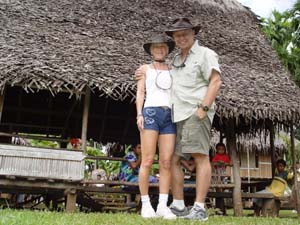
Donna was off having
a good time so I had a chance to check the automatic timer in my camera.
It looks like it works.
There were some houses which were
built directly on the ground but they were certainly the exception.
Me and my Gal.
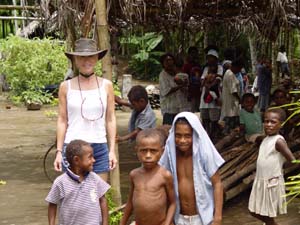
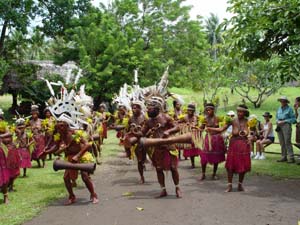

Donna found some people
shorter than her. She felt so empowered.
We were treated to a
show by the locals demonstrating their traditional dances and dress.
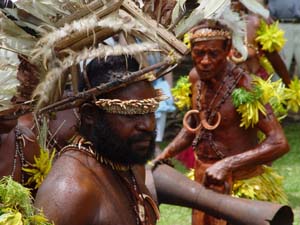
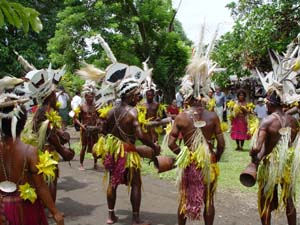

The primitive
nature of their songs gestures gave everyone pause.
Even the women looked strong.
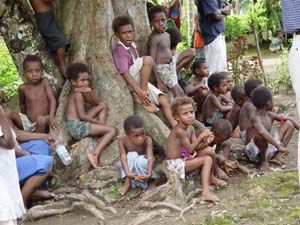
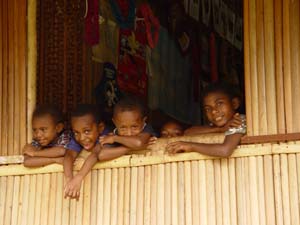
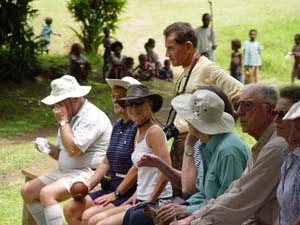
The bleachers were packed.
Even the balcony was packed.
Donna sat in the orchestra section.
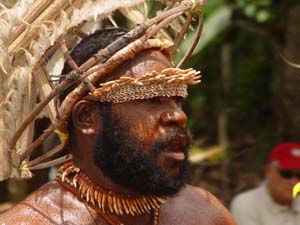


I'm not
sure if I would have felt too comfortable if I had met some of these fellas
about 100 years ago while hacking my way through the jungle. Is that necklace
made out of human fingers?
Donna and I with one of the dancers.
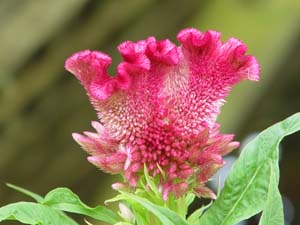
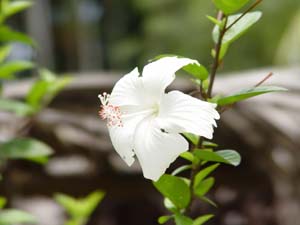
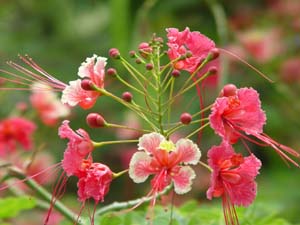
The flowers
were beautiful and unusual.

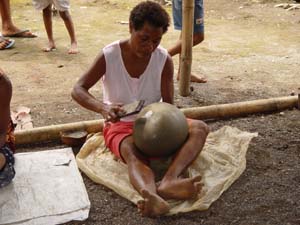

The second village we went to was famous for its traditional pottery. We were given a demonstration of how the pottery was made.
They had many pots for sale.
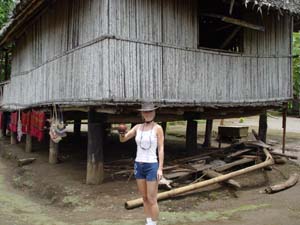

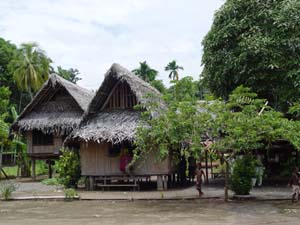
Donna did her part.
Here she is showing off her new pot. I let go of her hand for just 2 minutes!!!
She's fast.
Our friends Loren and Judy took the
tour too.
In spite of the fact that the village
was very primitive, it was a very clean place and people were all very
warm and friendly.

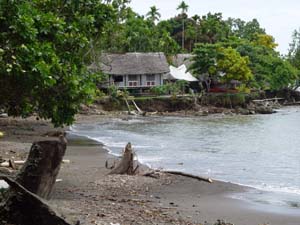
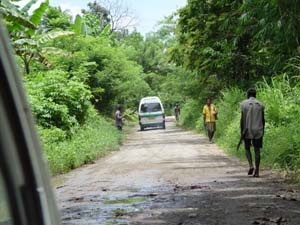
Us again.
The village beach was basic. We
were told when we returned to the ship that the snorkeling off of some
of the nicer beaches was terrific.
The roads we took from village to
village were not well maintained. Much of the movement of the locals was
on foot.
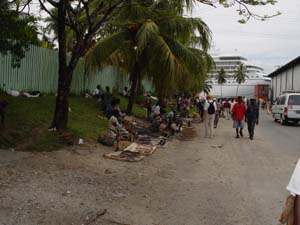
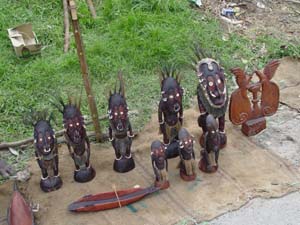
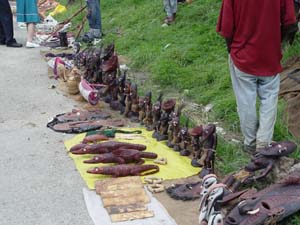
When we
got back to the ship the road leading to the dock had become a busy outdoor
bazaar. After lunch we ventured out and bought some trinkets. It was a
surprisingly pleasant experience due to the good nature and genuine warmth
of the locals.